Fiji is an archipelago in the South Pacific known for its stunning beaches, lush rainforests, and vibrant culture. It is also home to an impressive variety of birds, ranging from seabirds to tropical parrots.
Many of these birds are endemic to Fiji, meaning they are found nowhere else in the world. From the iconic Red Shining Parrot to the elusive Fijian Ground-dove, these birds are a key part of the islands’ unique ecosystems.
1. Fiji Goshawk
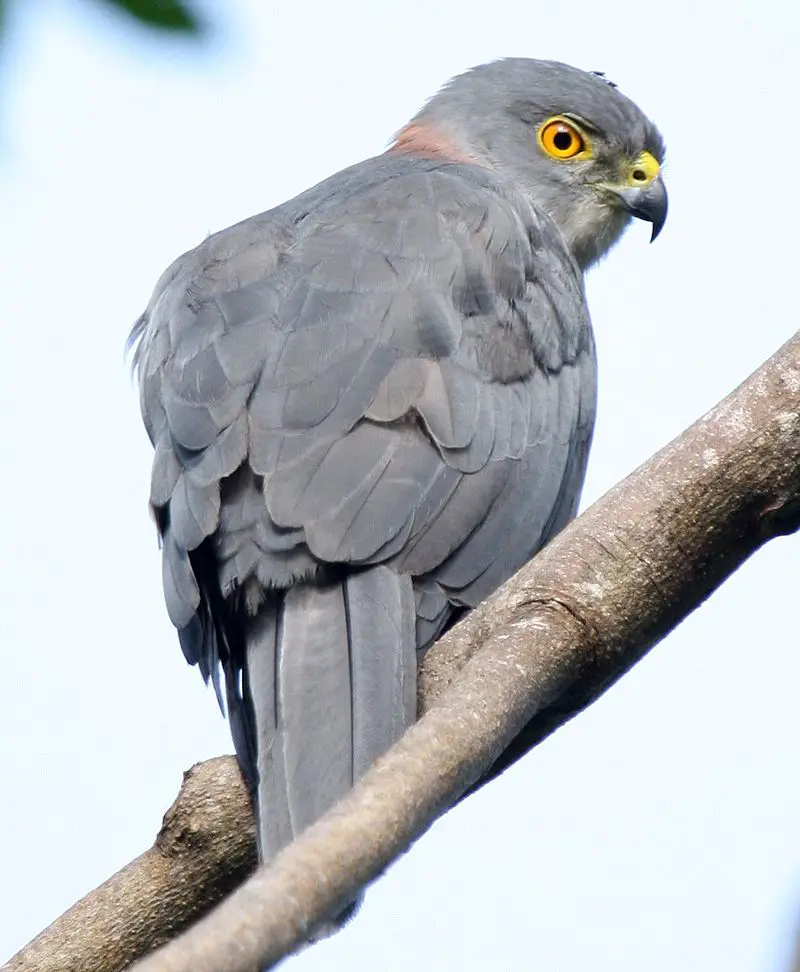
The Fiji goshawk is a species of bird of prey belonging to the Accipitridae family and endemic to Fiji.
It inhabits a variety of woodland habitats in the larger islands including Viti Levu, Vanua Levu, Taveuni, Kadavu, Gau and Ovalau.
This majestic creature has grey-brown upperparts with white underparts accompanied by dark barring on its chest.
Its wings are short but broad making it well adapted for hunting in dense vegetation or near ground level which is where they mostly feed on reptiles like lizards and small mammals such as rats and mice.
They are also known to take birds from urban areas when food sources become scarce during times of drought or scarcity.
The Fiji Goshawk plays an important role in maintaining ecological balance within their local environment by controlling populations of certain animal species that could otherwise cause serious damage to natural ecosystems if left unchecked.Scientific classification:
| Kingdom | Animalia |
| Phylum | Chordata |
| Class | Aves |
| Order | Accipitriformes |
| Family | Accipitridae |
| Genus | Accipiter |
| Species | A. rufitorques |
2. Fiji Parrotfinch
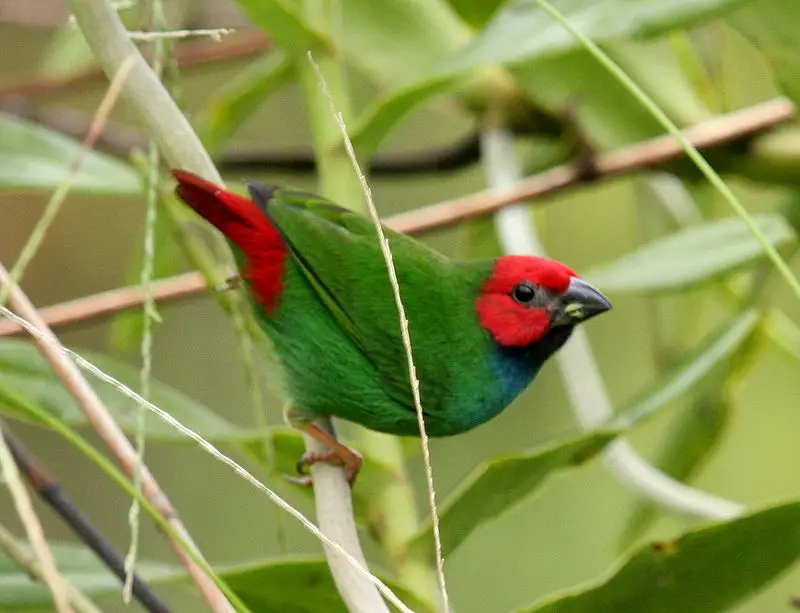
The stunning Fiji parrotfinch is a small, mainly green bird with a red head and tail. It has adapted well to its surroundings and can be found in both forested and open habitats as well as man-made environments such as grasslands, pastures and gardens.
Its stubby dark grey bill allows it to feed on seeds of various plants while its colourful plumage makes it stand out from the crowd.
The species is endemic to Fiji although was formerly considered a subspecies of the Redhead Parrotfinch.
This hardy little finch will make an excellent addition to any aviary or garden setting due its adaptability for many different types of food sources, easy maintenance requirements and friendly demeanor towards other birds.Scientific classification:
| Kingdom | Animalia |
| Phylum | Chordata |
| Class | Aves |
| Order | Passeriformes |
| Family | Estrildidae |
| Genus | Erythrura |
| Species | E. pealii |
3. Orange Fruit Dove
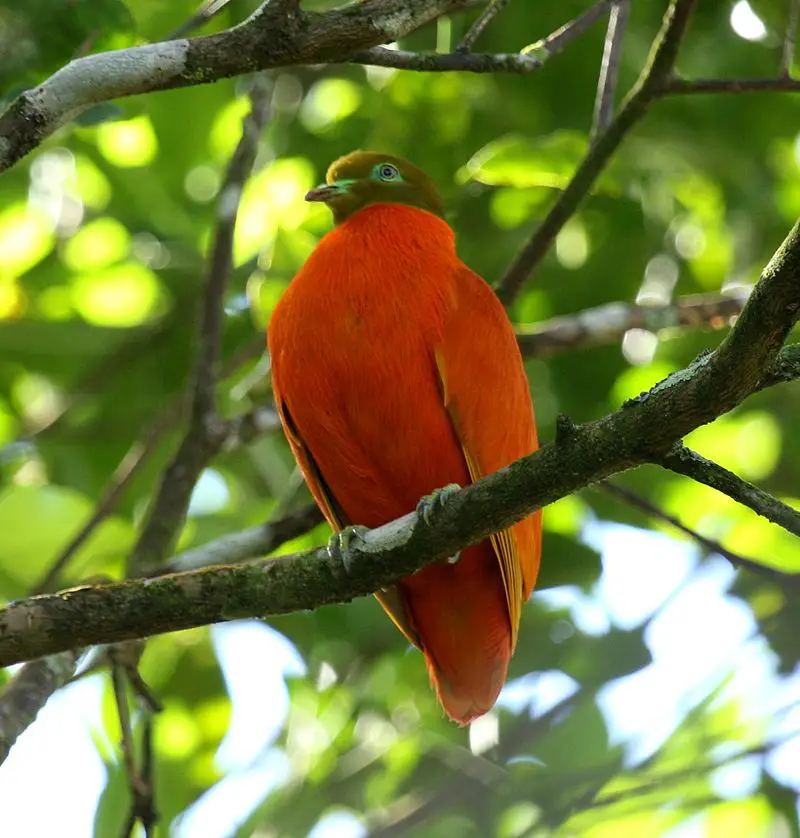
The Orange Fruit Dove is a stunningly colorful species of pigeon in the family Columbidae. The male has an olive green head and bright orange body feathers that look like hair when perched.
Its legs, bill, and skin around its eyes are bluish-green while its iris is whitish. In contrast to the vibrant colors of the males, females have more muted plumage with brown bodies accented by light spots on their wings.
They feed primarily on fruit found in tropical forests such as figs or berries but will also eat insects from time to time for added nutrients.
Their calls consist of soft cooing noises which can be heard throughout much of their range during mating season.Scientific classification:
| Kingdom | Animalia |
| Phylum | Chordata |
| Class | Aves |
| Order | Columbiformes |
| Family | Columbidae |
| Genus | Ptilinopus |
| Species | P. victor |
4. Golden Fruit Dove
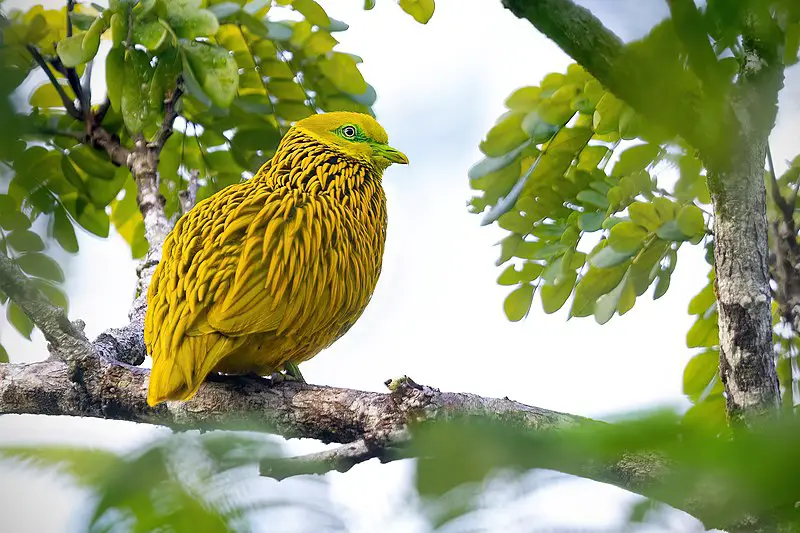
The Golden fruit dove is a beautiful sight to behold, with its bright golden-yellow body and slightly duller green head.
It has an impressive wingspan of around 20 cm (8 in) that gives it the iridescent look due to their elongated shape and hair-like texture.
This small short tailed member of the Columbidae family can be found in tropical forests throughout parts of South East Asia, inhabiting both lowland primary rainforest as well as more open areas such as secondary growth forest edges and riverbanks.
The diet primarily consists of fruits, nuts and seeds which they forage from trees or shrubs though during breeding season insects may also make up part of their meals.
They are relatively easy to spot when perched on branches usually alone or pairs but occasionally larger flocks will form too.Scientific classification:
| Kingdom | Animalia |
| Phylum | Chordata |
| Class | Aves |
| Order | Columbiformes |
| Family | Columbidae |
| Genus | Ptilinopus |
| Species | P. luteovirens |
5. Barking Imperial Pigeon
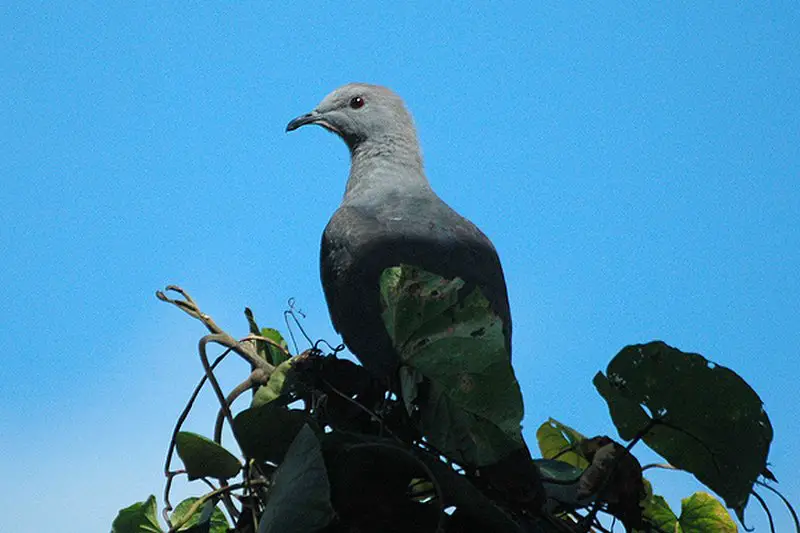
The Barking Imperial Pigeon is a species of bird in the Columbidae family, which is native to Fiji.
It’s found on most medium and large islands throughout the region and inhabits both mature tropical moist lowland forests as well as montane forests.
This imperial pigeon has distinctive features such as its slate-blue head that contrasts with its pinkish white neck feathers and grey body plumage.
Its bill is black at the base but fades into yellow towards its tip while it also possesses bright red eyes rings around them.
The barkinig imperial pigeon can be identified by their loud calls heard during flight or when perched atop trees in pairs or small groups.Scientific classification:
| Kingdom | Animalia |
| Phylum | Chordata |
| Class | Aves |
| Order | Columbiformes |
| Family | Columbidae |
| Genus | Ducula |
| Species | D. latrans |
6. Many-Colored Fruit Dove
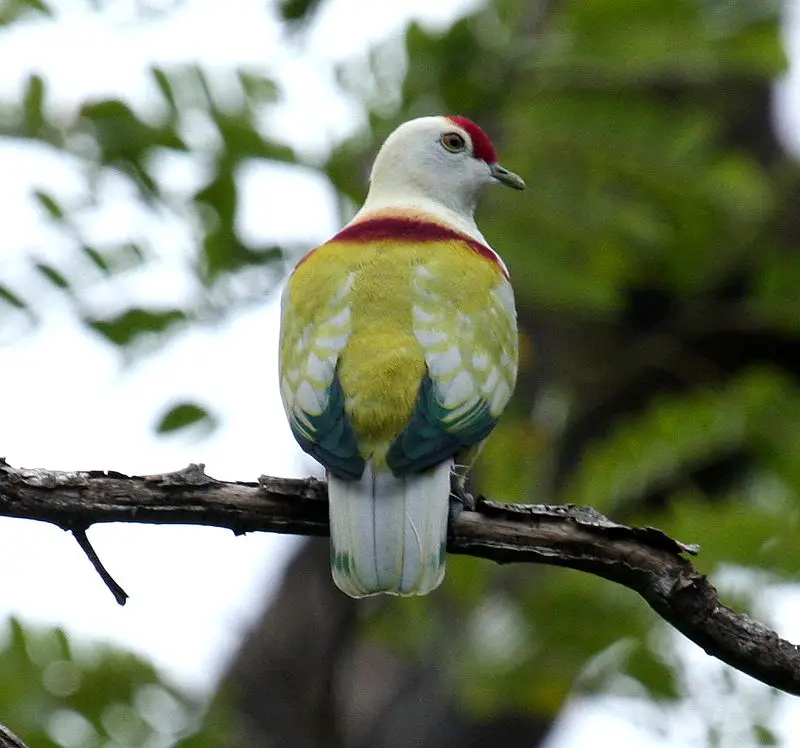
The many-colored fruit dove, also known as the manuma in Samoan language, is a species of bird belonging to the family Columbidae.
It inhabits subtropical or tropical moist lowland forests on islands in Fiji, Samoa and Tonga.
The birds are usually spotted foraging for food among trees during the day but nest at night.
They feed mainly on fruits from various tree species with some insects supplementing their diet occasionally.
These beautiful doves have brightly coloured feathers ranging from white to yellowish green depending upon its age and gender; they make attractive pets when tamed correctly.
With proper conservation efforts we can ensure these stunning creatures remain part of our environment for years to come.Scientific classification:
| Kingdom | Animalia |
| Phylum | Chordata |
| Class | Aves |
| Order | Columbiformes |
| Family | Columbidae |
| Genus | Ptilinopus |
| Species | P. perousii |
7. Sulphur-Breasted Myzomela
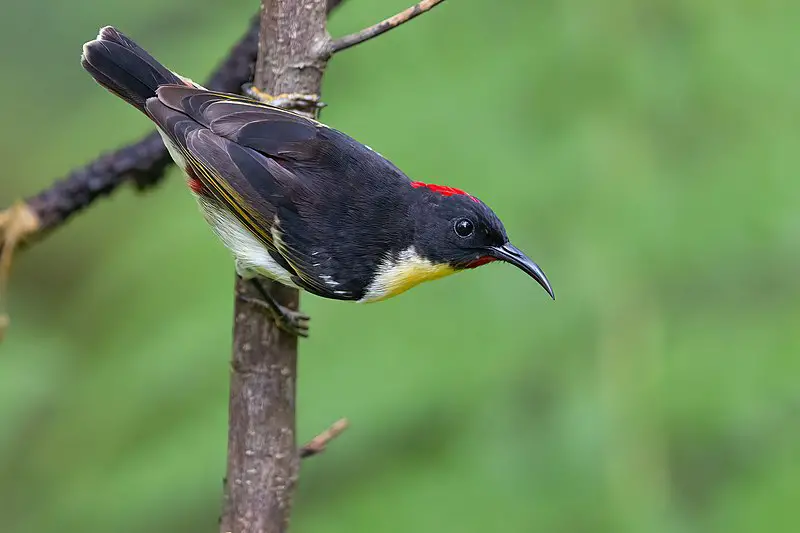
The Sulphur-breasted Myzomela is a small bird that can be found in the family Meliphagidae. It has black upperparts, with a scarlet rump and pale yellow-white underparts.
Its bill and feet are also black while males have an additional scarlet crown.
This species measures around 10 cm long and typically inhabits woodlands of Australia’s east coast as well as New Guinea, where it feeds on nectar from flowers or takes insects off foliage.
The breeding season for this bird usually happens during autumn to spring when they build their nests made out of grasses, bark strips and spider webs near tree trunks or low shrubs located up to 6 m high above ground level.Scientific classification:
| Kingdom | Animalia |
| Phylum | Chordata |
| Class | Aves |
| Order | Passeriformes |
| Family | Meliphagidae |
| Genus | Myzomela |
| Species | M. jugularis |
8. Fiji Woodswallow
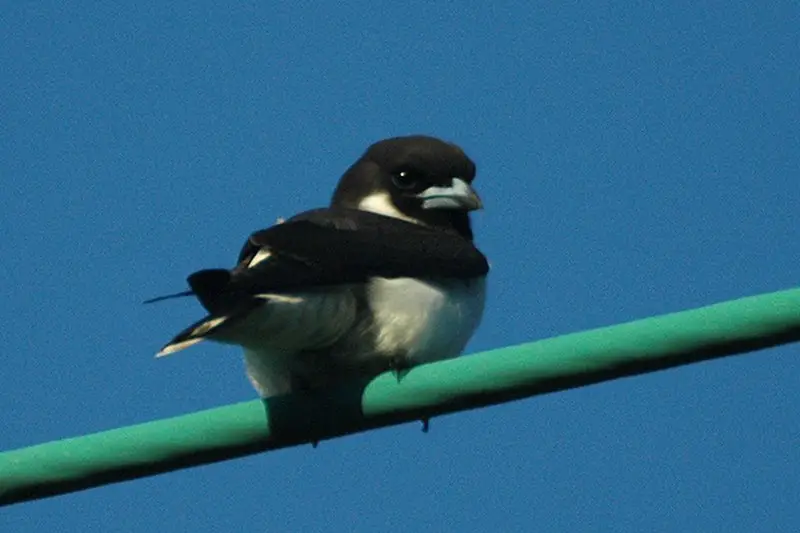
The Fiji woodswallow is a species of bird native to the islands of Fiji, found throughout most parts except for Kadavu Archipelago and Lau Archipelago.
It was previously believed to be a race of white-breasted woodswallow that breeds from Australia all the way through East Asia.
This small passerine bird has an overall greyish brown plumage with black wings and distinctive yellow patches on its face and throat.
The female’s features are slightly duller than those seen in males.
They feed mainly on insects but have also been known to eat fruits, berries or nectar if available around their habitat areas – usually open forests or grasslands near freshwater bodies such as swamps, streams or riverside vegetation .Scientific classification:
| Kingdom | Animalia |
| Phylum | Chordata |
| Class | Aves |
| Order | Passeriformes |
| Family | Artamidae |
| Genus | Artamus |
| Species | A. mentalis |
9. Red-Throated Lorikeet
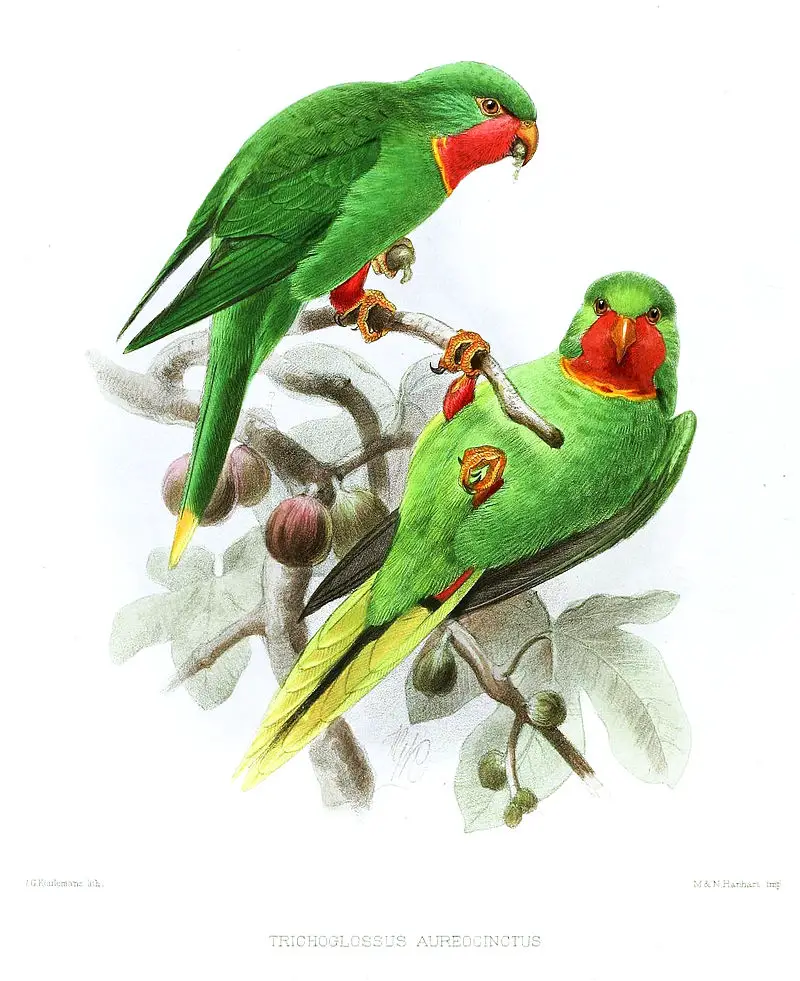
The Red-throated Lorikeet is a critically endangered species endemic to Fiji. It measures 18 cm in length and has an overall bright green plumage, with red cheeks, throat and thighs.
Historically it was found on Viti Levu, Vanua Levu, Taveuni and Ovalau islands but there have been no reliable sightings since 1993 – although some believe they may still be present on Mount Tomanivi of Viti Levu.
This bird is under threat from habitat destruction due to deforestation as well as human hunting for food or pet trade purposes; their population continues to decline if conservation efforts are not put into place soon.
Therefore more research needs to be conducted in order preserve this unique species before its too late.Scientific classification:
| Kingdom | Animalia |
| Phylum | Chordata |
| Class | Aves |
| Order | Psittaciformes |
| Family | Psittaculidae |
| Genus | Vini |
| Species | V. amabilis |
10. Pink-Billed Parrotfinch
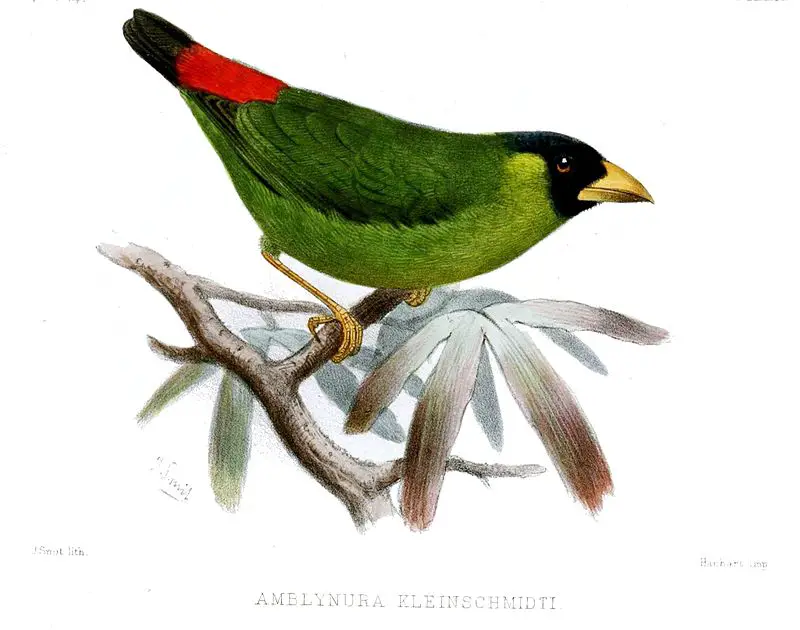
The Pink-billed parrotfinch is a delightful species of estrildid finch found on the island of Viti Levu, Fiji.
It typically resides in undisturbed mature forests and is most commonly seen at mid-height along tree trunks or branches, though it can also form mixed flocks with other birds.
The diet mainly consists of insects – an important source of protein for this bird. Its striking pink bill helps to distinguish it from its fellow Fijian finches and makes it one of the more attractive birds native to this region.
Despite being common in some areas, habitat destruction could threaten their future population so conservation efforts are crucial to ensure they don’t become threatened by extinction.Scientific classification:
| Kingdom | Animalia |
| Phylum | Chordata |
| Class | Aves |
| Order | Passeriformes |
| Family | Estrildidae |
| Genus | Erythrura |
| Species | E. kleinschmidti |
11. Fiji White-Eye
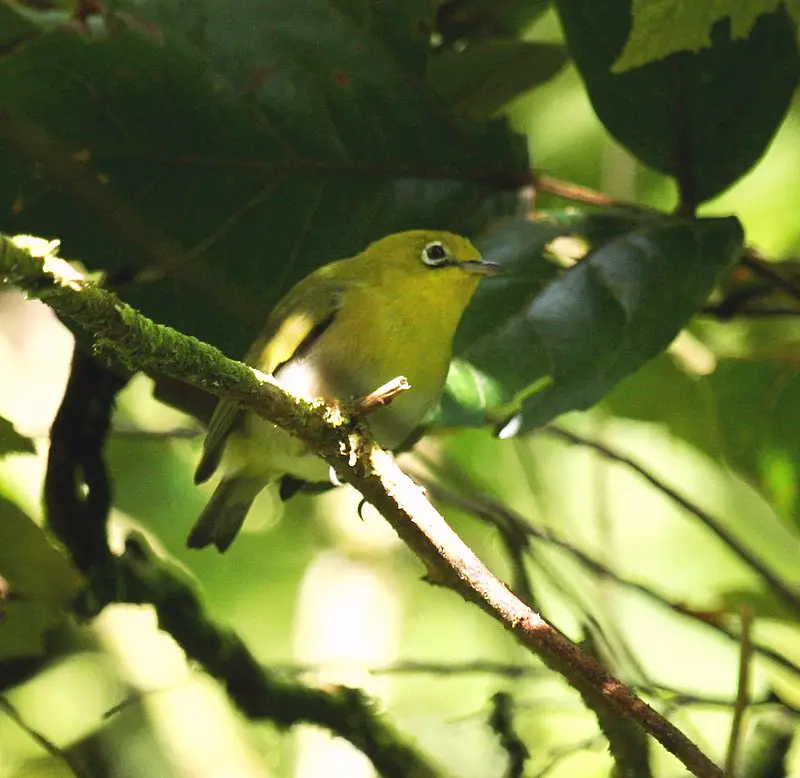
The Fiji white-eye is a species of passerine bird belonging to the family Zosteropidae. It is endemic to the islands of Viti Levu, Vanua Levu, Taveuni, Kadavu and Ovalau in Fiji where it can be found in forests.
The bird has an olive green upper body with yellowish underparts, making it easy to identify from other birds.
Its diet mainly consists of fruits and small insects taken from vegetation or caught midflight.
In areas where it coexists with its closely related silvereye cousin, the former tends to inhabit denser parts of forested regions due to competition for food sources like nectar and fruit pulp which are their main source of sustenance.
With its lovely song that helps define Fijian landscapes this little eye will continue bringing joys into many observers lives.Scientific classification:
| Kingdom | Animalia |
| Phylum | Chordata |
| Class | Aves |
| Order | Passeriformes |
| Family | Zosteropidae |
| Genus | Zosterops |
| Species | Z. explorator |
12. Red-Vented Bulbul
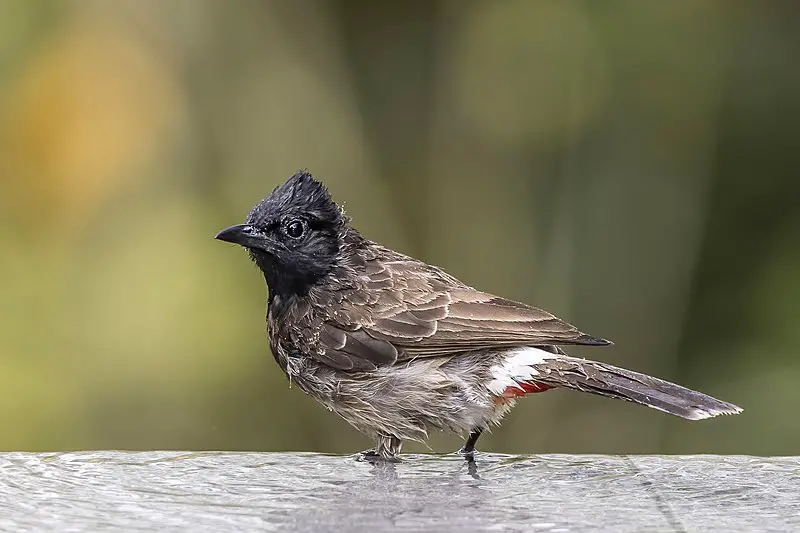
The Red-vented Bulbul is an impressive bird native to the Indian subcontinent, and has been introduced to regions around the world.
It belongs to the bulbul family of passerines and is a resident breeder in many countries including Sri Lanka, Burma, Bhutan and Nepal.
It also thrives in New Zealand, Argentina, Tonga and Fiji as well as parts of Samoa, Australia USA and Cook Islands.
This species has grey heads with white cheeks that contrast sharply against their black wings with bright red vent feathers which give them their name.
They typically live near woodland areas where they can forage for fruits or small insects on trees or bushes; this makes them useful birds for controlling insect populations naturally.
The male red-vented bulbuls are renowned songsters who sing out from treetops at dawn each day – adding some beautiful melodies to any garden.Scientific classification:
| Kingdom | Animalia |
| Phylum | Chordata |
| Class | Aves |
| Order | Passeriformes |
| Family | Pycnonotidae |
| Genus | Pycnonotus |
| Species | P. cafer |
13. Azure-Crested Flycatcher
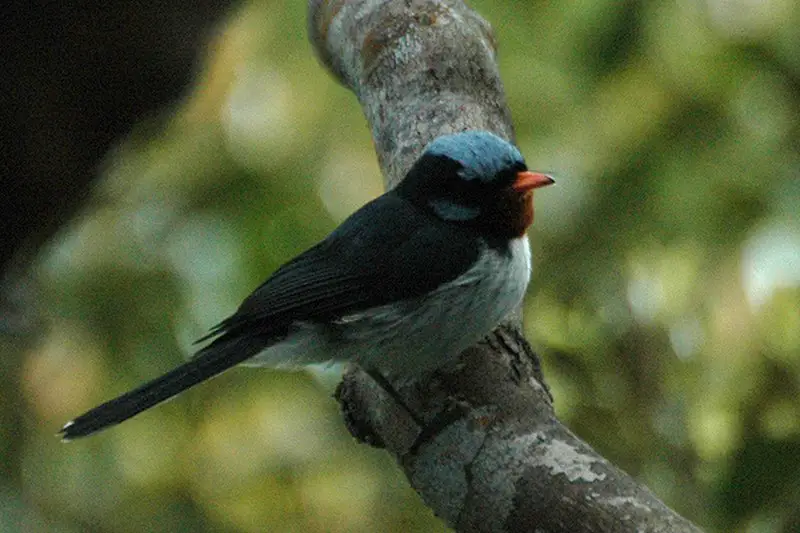
The Azure-crested Flycatcher is a species of bird belonging to the family Monarchidae. It is found exclusively in Fiji, more specifically on Taveuni Island.
This small bird inhabits both subtropical and tropical moist lowland forests as well as montane forests.
The first description of this species was made by ornithologist in 1875.
It has a bright blue crest covering its head which makes it an easily identifiable species with smooth grayish upperparts, white underparts and black wings with two pale bars across them.
Its diet consists mainly of insects that are caught while foraging among foliage or hovering over water bodies such as streams and rivers.
It also sometimes feeds on fruit from nearby trees during its flight between different habitats within its range area .Scientific classification:
| Kingdom | Animalia |
| Phylum | Chordata |
| Class | Aves |
| Order | Passeriformes |
| Family | Monarchidae |
| Genus | Myiagra |
| Species | M. azureocapilla |
14. Whistling Fruit Dove
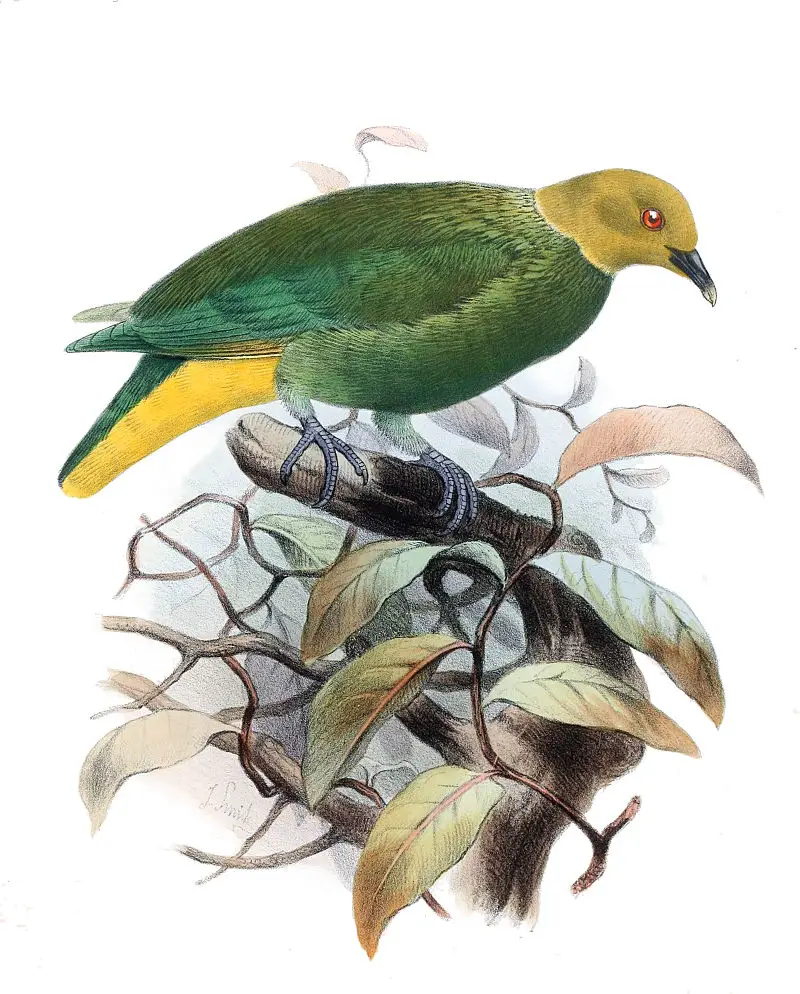
The Whistling Fruit Dove is a small and beautiful fruit dove native to the Kadavu Group islands in Fiji. It has an unmistakable yellow head, bright greenish-blue back and wings, as well as white underparts.
This species of bird loves eating fruits, which it finds on tropical trees or shrubs. Its distinctive call is similar to whistling; hence its name.
The Whistling Fruit Dove is the most primitive subgroup of Ptilinopus doves found in Fiji along with two other Fijian species – the golden dove and purple-crowned lorikeet.
These birds are relatively common but still vulnerable due to habitat destruction caused by deforestation for development purposes.
They can also be threatened by predation from domestic cats and rats that have been introduced into their habitats.Scientific classification:
| Kingdom | Animalia |
| Phylum | Chordata |
| Class | Aves |
| Order | Columbiformes |
| Family | Columbidae |
| Genus | Ptilinopus |
| Species | P. layardi |
15. Polynesian Triller
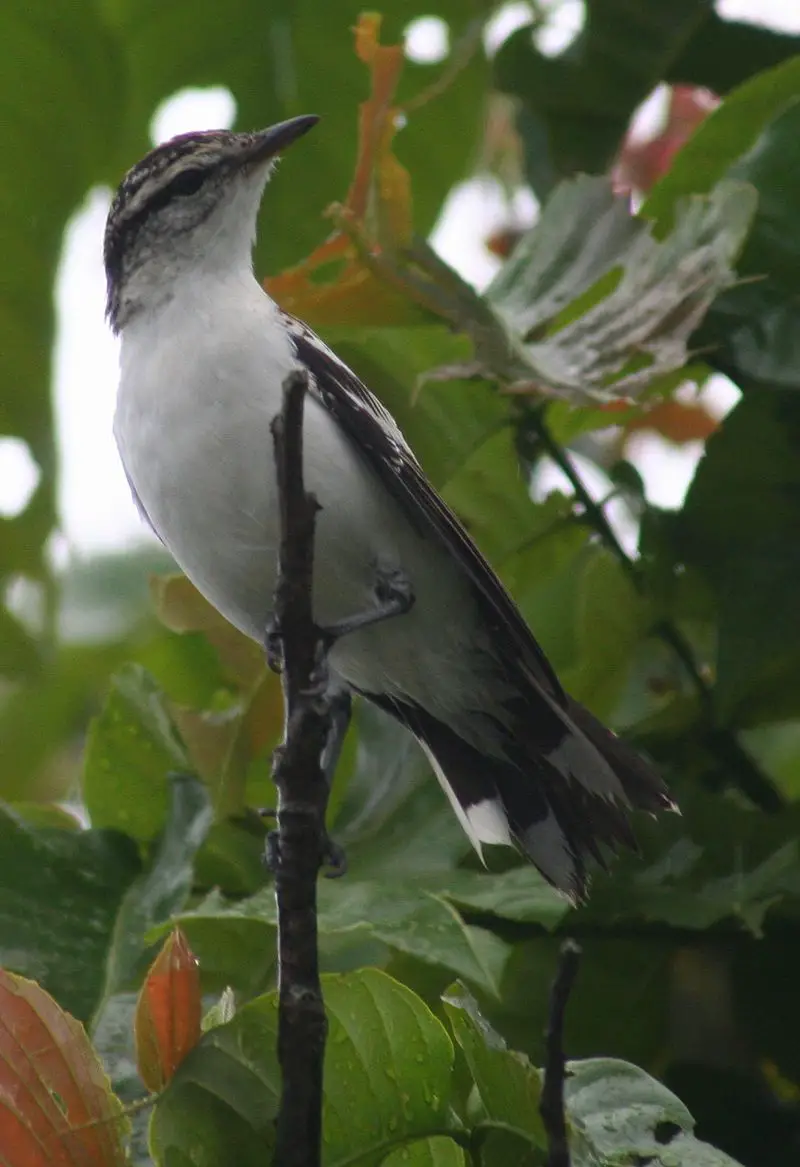
The Polynesian triller is a small passerine bird belonging to the cuckoo-shrike family Campephagidae.
It has numerous subspecies distributed across south-west Pacific islands and can grow up to 15–16 cm in length, with geographically varying plumage ranging from black and white to grey or brown coloration.
This species is known for its loud call which it makes almost constantly throughout the day, making it one of the most conspicuous birds on many tropical islands where it resides.
Its diet consists mainly of insects but will also take fruits when available during times of scarcity.
The Polynesian triller is an important part of island ecosystems as both predator and prey; helping regulate insect populations while providing food for other animals such as snakes and owls.Scientific classification:
| Kingdom | Animalia |
| Phylum | Chordata |
| Class | Aves |
| Order | Passeriformes |
| Family | Campephagidae |
| Genus | Lalage |
| Species | L. maculosa |
16. Streaked Fantail
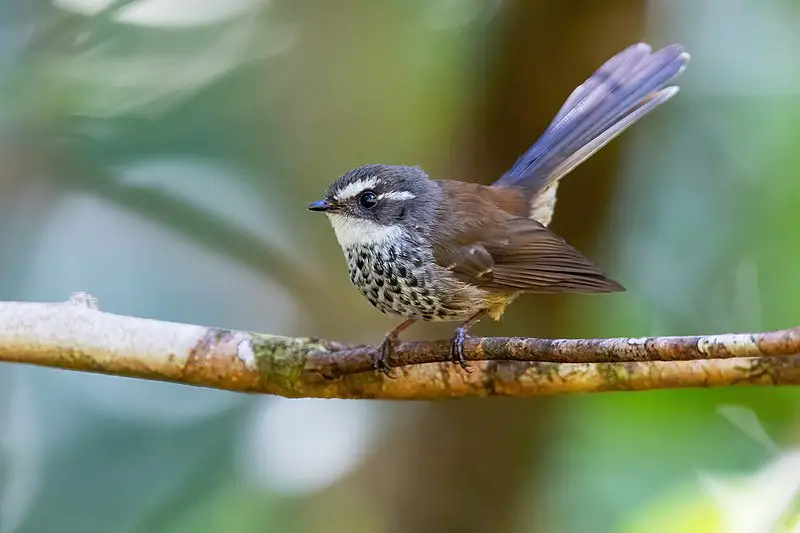
The Streaked Fantail is a species of bird belonging to the family Rhipiduridae. Found in Fiji, New Caledonia and Vanuatu, its natural habitat consists of lush subtropical or tropical lowland forests and moist montane forests.
According to IOC there are five recognised subspecies; Rhipidura verreauxi macgillivrayi (New Caledonia), Rhipidura v. melanorhyncha (Vanuatu) ,Rhipidura v mixta (Fiji’s Lau group); Rhipidura v ruficollis(Viti Levu & Kadavu islands) & Rhopdira V spilodera (eastern Fiji).
This small brown-grey coloured fantail has white streaks across its wings which give it a distinctive look when flying amongst other birds in the region.
It also possesses unique rummaging movements whilst hunting for food on the ground with short hops that make it stand out from other similar looking species.’Scientific classification:
| Kingdom | Animalia |
| Phylum | Chordata |
| Class | Aves |
| Order | Passeriformes |
| Family | Rhipiduridae |
| Genus | Rhipidura |
| Species | R. verreauxi |
Also Featured In: Birds of New Caledonia,
17. Fiji Petrel
The Fiji petrel is a small and dark-coloured gadfly petrel, first discovered in 1855 by naturalist John MacGillivray on board HMS Herald while he was exploring Gau Island in Fiji.
This specimen was taken to the British Museum of London after its discovery. The bird wasn’t seen again until 1983 when it reappeared with 21 more records since then.
It’s considered one of the rarest seabirds found only on islands located off New Zealand and Australia as well as some parts of Indonesia, Micronesia and French Polynesia.
Currently, conservation efforts are underway for this species for their protection from extinction due to human activities like fishing or land clearance which can be detrimental to these birds’ habitats.Scientific classification:
| Kingdom | Animalia |
| Phylum | Chordata |
| Class | Aves |
| Order | Procellariiformes |
| Family | Procellariidae |
| Genus | Pseudobulweria |
| Species | P. macgillivrayi |
18. Fiji Whistler
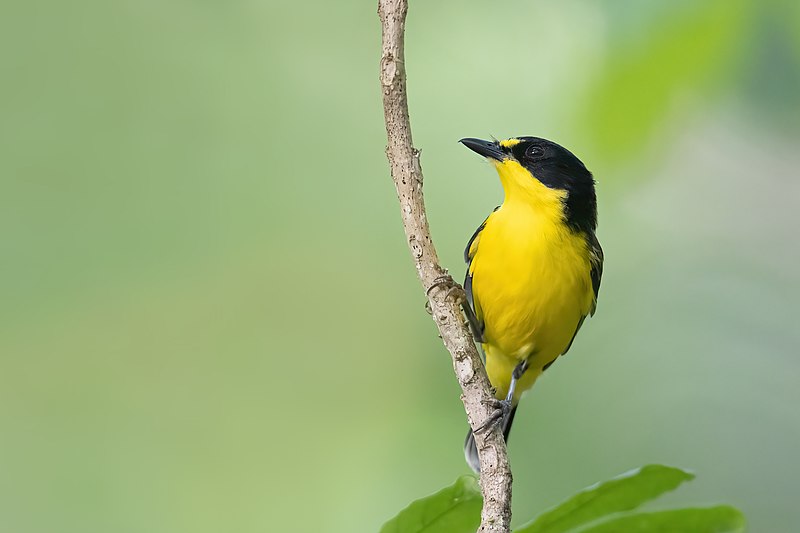
The Fiji whistler is a species of bird found only in the Fijian Islands. It belongs to the family Pachycephalidae and was previously thought to be a subspecies of golden whistler (P.
pectoralis). In 2014, three subspecies that were part of white-throated whistlers (P. v. kandavensis, lauana and vitiensis) were combined with the Fiji whislerer as one distinct species due to its notable differences from other members within this genus.
The main distinguishing feature being its brownish black coloration on top contrasted by an off-white underbelly along with yellow stripes underneath each eye making it quite visually striking among passerines native to these islands.Scientific classification:
| Kingdom | Animalia |
| Phylum | Chordata |
| Class | Aves |
| Order | Passeriformes |
| Family | Pachycephalidae |
| Genus | Pachycephala |
| Species | P. vitiensis |
19. Kadavu Fantail
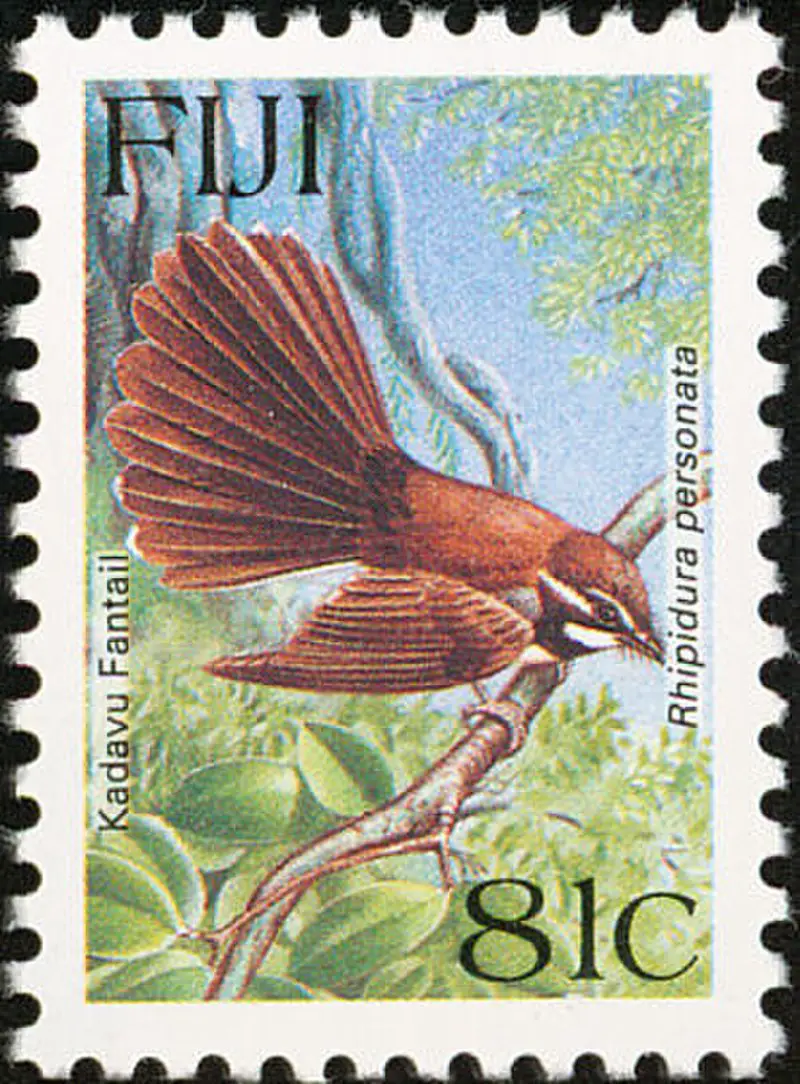
The Kadavu fantail is a species of bird in the Rhipiduridae family, endemic to Kadavu and Ono islands in southern Fiji.
It belongs to the same superspecies as other island-dwelling fantails ranging from Solomon Islands (the brown fantail) to Samoa (the Samoan fantail).
This small bird has an olive upper body with yellow underparts and wings, black tail feathers tipped white, and a bright orange patch on its throat.
Its diet consists mainly of flying insects which it captures by making quick sallies through trees or low vegetation.
The male will perform flight displays during courtship rituals as part of mating behavior.
They can be found foraging alone or in pairs throughout forested areas near streams or gardens within their range.Scientific classification:
| Kingdom | Animalia |
| Phylum | Chordata |
| Class | Aves |
| Order | Passeriformes |
| Family | Rhipiduridae |
| Genus | Rhipidura |
| Species | R. personata |
20. Taveuni Silktail
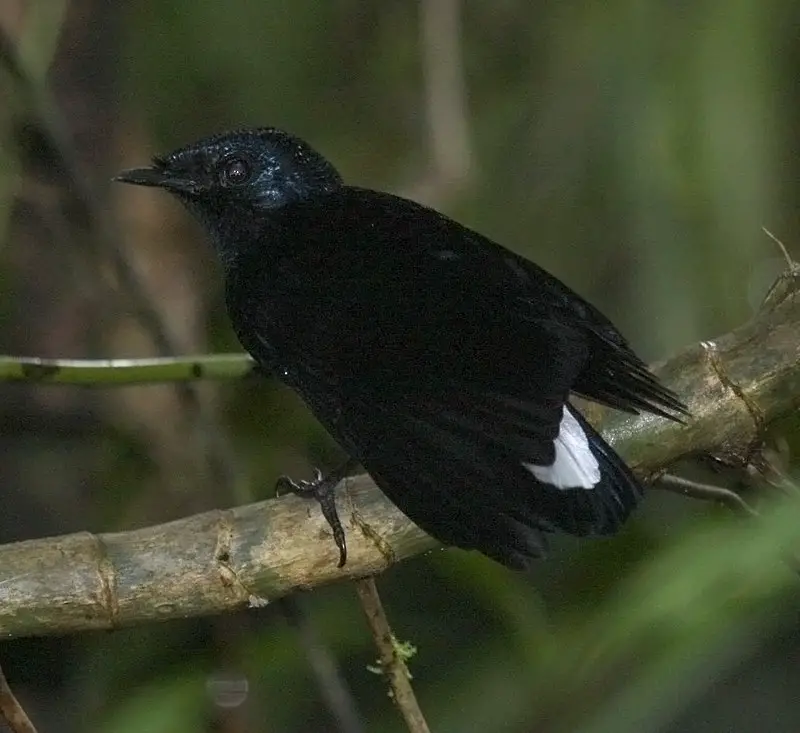
The Taveuni silktail is a stunning bird that is endemic to Fiji. Despite its appearance, it is closely related to the fantails rather than the birds-of-paradise.
It was named after Victoria, eldest daughter of Queen Victoria who was Crown Princess at the time.
This delightful species measures around 12 centimetres and has black plumage with a white stripe on each wing and yellow feathers below each eye.
They are found in forests where they feed predominantly on insects by making short sallies from perches as well as gleaning foliage for food items.
The diet also includes small fruits too during certain times of year when availableScientific classification:
| Kingdom | Animalia |
| Phylum | Chordata |
| Class | Aves |
| Order | Passeriformes |
| Family | Rhipiduridae |
| Genus | Lamprolia |
| Species | L. victoriae |
21. Pacific Imperial Pigeon
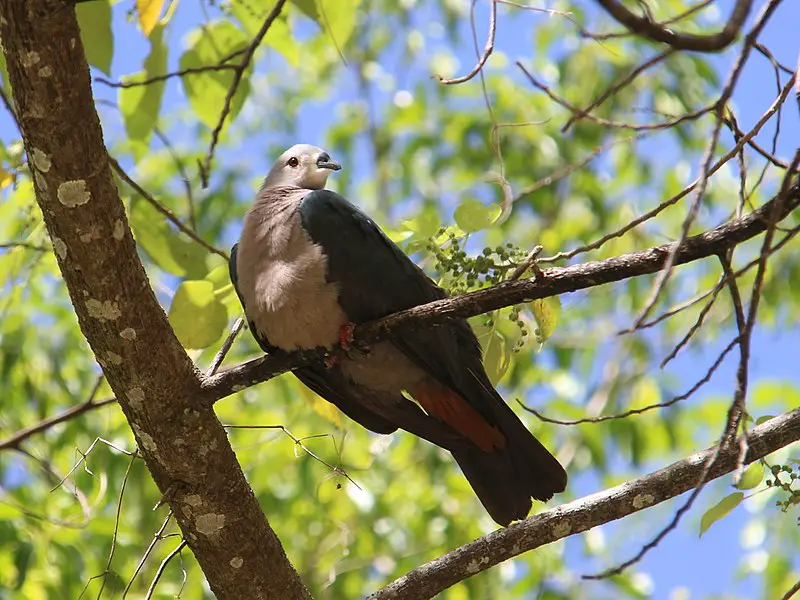
The Pacific imperial pigeon is a beautiful species of bird found in many islands located throughout the South Pacific. It has an iridescent green body, white neck and head with black markings around its eyes and beak.
Its wings are reddish-brown with a large area of blue on each side near the tips. This majestic creature was formally described by Johann Friedrich Gmelin in 1788 and it can grow up to 11 inches long with a wingspan reaching 33 inches wide.
The diet of this amazing avian consists mainly of fruits like figs, mangos, breadfruit, guavas as well as seeds which they search for while flying low over forests or woodlands.
As one can imagine these birds have become very important culturally to many people living within their range due to their beauty and stunning colors.Scientific classification:
| Kingdom | Animalia |
| Phylum | Chordata |
| Class | Aves |
| Order | Columbiformes |
| Family | Columbidae |
| Genus | Ducula |
| Species | D. pacifica |
22. Fiji Shrikebill
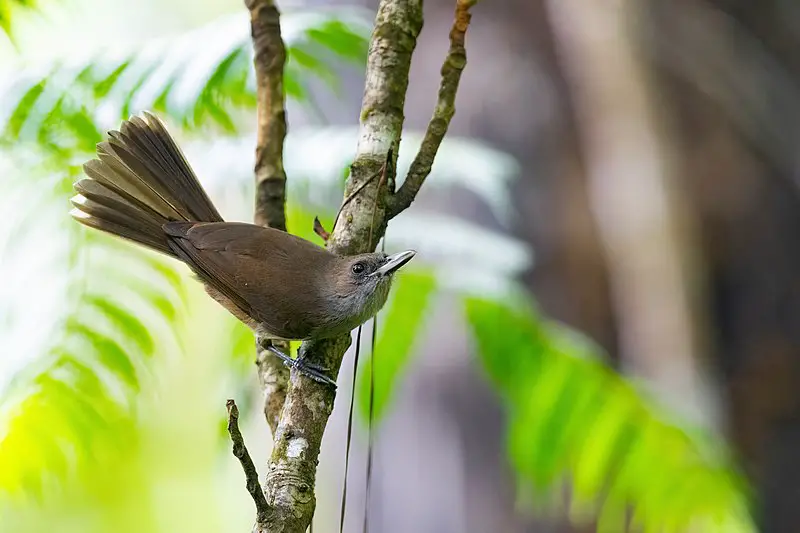
The Fiji Shrikebill is a songbird found in American Samoa, Fiji and Tonga. It inhabits subtropical or tropical moist lowland forests and was originally classified as belonging to the genus Myiolestes.
Twelve subspecies of this bird have been discovered, which are distinguishable by their size and plumage colouration.
The common name for this species comes from its distinctive bill shape -it resembles that of a shrike- along with an alternate moniker; the uniform shrikebill.
This small but beautiful creature has mainly grey feathers on its body while darker shades adorn its wings and tail tip; males also boast faint chestnut markings around their eyes making them easily recognisable amongst other birds in the area.Scientific classification:
| Kingdom | Animalia |
| Phylum | Chordata |
| Class | Aves |
| Order | Passeriformes |
| Family | Monarchidae |
| Genus | Clytorhynchus |
| Species | C. vitiensis |
23. Yellow-Billed Honeyeater
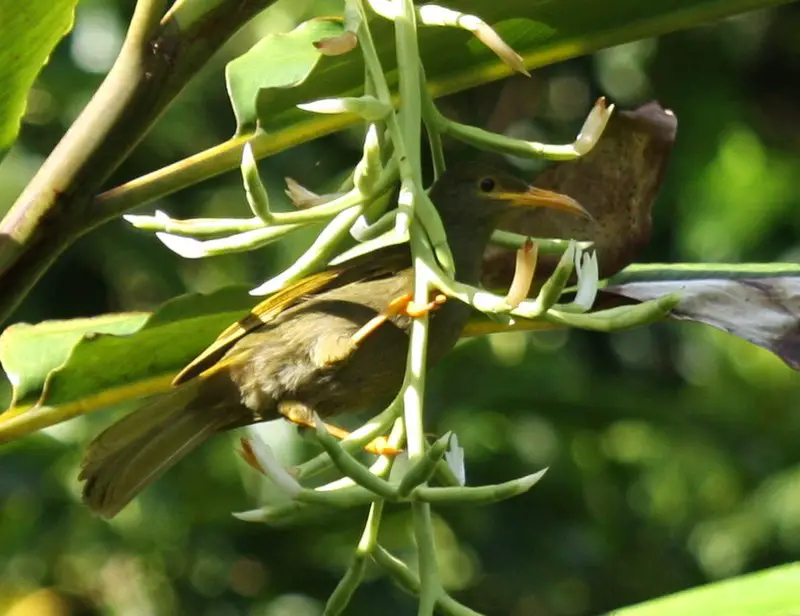
The Yellow-billed Honeyeater is a species of bird found in the Meliphagidae family and is endemic to Fiji.
This small, melodic bird can be found inhabiting subtropical or tropical moist lowland forest as well as montane forests on Vanua Levu and Taveuni islands.
Unfortunately, due to habitat loss it has been classified as threatened by The IUCN Red List of Threatened Species.
It’s nickname ‘yodeling giant honeyeater’ comes from its loud call which consists of long series of whistles that increase in pitch before decreasing again – sounding like yodel.
Its other name ‘chattering giant honeyeater’ arises out of its habit for making a constant chattering noise with other birds when forming mixed flocks while feeding together on flowers and fruits.Scientific classification:
| Kingdom | Animalia |
| Phylum | Chordata |
| Class | Aves |
| Order | Passeriformes |
| Family | Meliphagidae |
| Genus | Gymnomyza |
| Species | G. viridis |
24. Collared Petrel
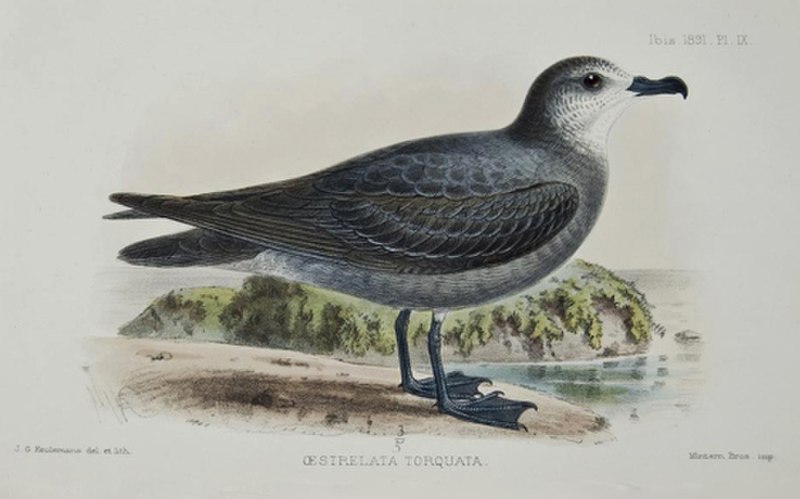
The Collared Petrel is a species of seabird belonging to the Procellariidae family. It can be found in Fiji, where it breeds on Gau Island and possibly other islands, as well as potentially breeding in Vanuatu, Cook Islands and Solomon Islands.
Its plumage predominantly consists of greyish-brown colouring with white underparts and collar around its neck; this gives them their name ‘Collared’ petrels.
They are known to migrate over long distances out at sea during winter months before returning home for the summer season when they breed between August – April.
These birds feed primarily upon squid but also take small fish from surface waters or deeper depths depending on availability/seasonality.
Although not endangered yet conservation efforts need to continue so that these beautiful birds remain protected within our environment.Scientific classification:
| Kingdom | Animalia |
| Phylum | Chordata |
| Class | Aves |
| Order | Procellariiformes |
| Family | Procellariidae |
| Genus | Pterodroma |
| Species | P. brevipes |
Also Featured In: Common Republic of Nauru Birds,
25. White-Rumped Swiftlet
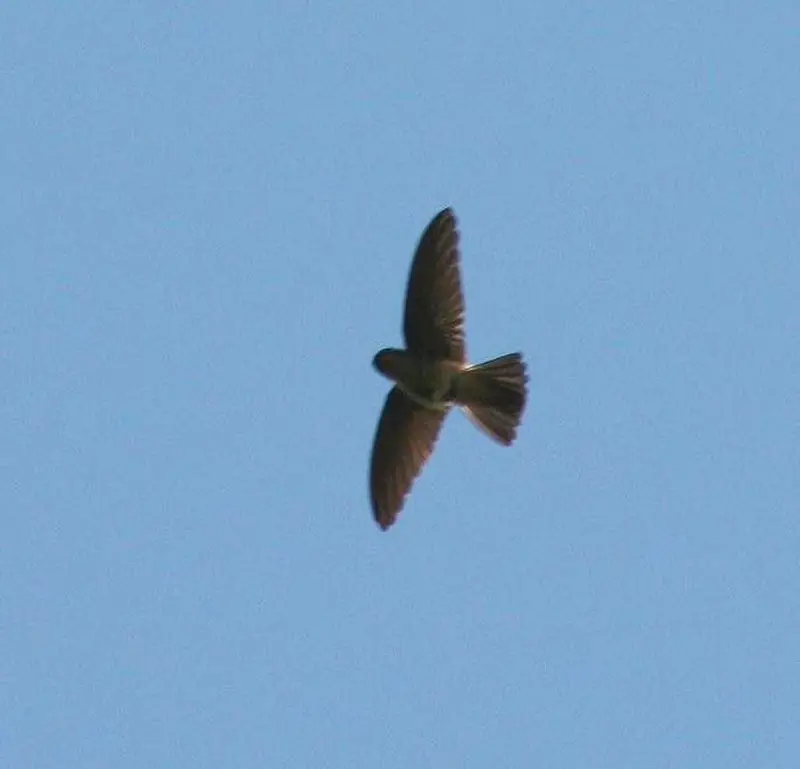
The White-rumped Swiftlet is a species of swift found in the Pacific Islands, including American Samoa, Fiji, New Caledonia and Vanuatu.
It has also been seen in Papua New Guinea and Solomon Islands.
This bird inhabits subtropical or tropical moist lowland forests where it feeds on flying insects such as termites, beetles and flies.
Its main predators are hawks while other threats include deforestation due to logging activities which may reduce its habitat size significantly.
The Australian population was considered separate species (Aerodramus terraereginae) until recently when researchers recognized them as one single species again.
Conservation efforts for this beautiful bird must be done if we want future generations to witness its gracefulness taking flight across our skies.Scientific classification:
| Kingdom | Animalia |
| Phylum | Chordata |
| Class | Aves |
| Order | Apodiformes |
| Family | Apodidae |
| Genus | Aerodramus |
| Species | A. spodiopygius |
26. Slaty Monarch
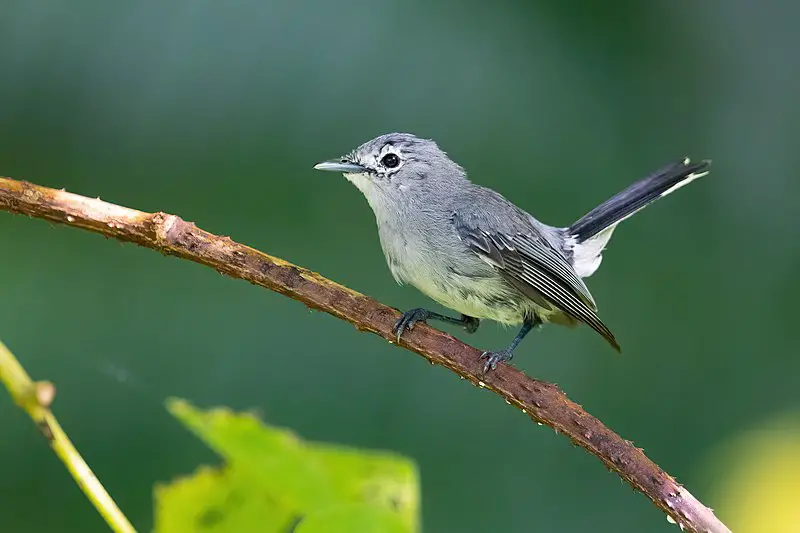
The Slaty Monarch is a species of bird belonging to the family of Monarachidae, and it is endemic to Fiji.
It lives in subtropical or tropical moist lowland forests and can be found near water bodies like rivers, streams or lakes.
This bird has an overall greyish-blue body with black markings on its wings which makes it stand out among other birds.
The slaty monarch was originally classified under Rhipidura genus but later reclassified into Mayrornis lessoni by renowned ornithologists due to its unique characteristics that distinguished it from other birds.
Besides being known as the ‘Slaty Flycatcher’, this magnificent creature also goes by many alternate names such as ‘Cinereous Flycatcher’ , ‘Fiji flycatcher’ and so forth. All in all, this beautiful avian deserves appreciation for its remarkable features making us fall in love with nature even more.Scientific classification:
| Kingdom | Animalia |
| Phylum | Chordata |
| Class | Aves |
| Order | Passeriformes |
| Family | Monarchidae |
| Genus | Mayrornis |
| Species | M. lessoni |
27. Crimson-Crowned Fruit Dove
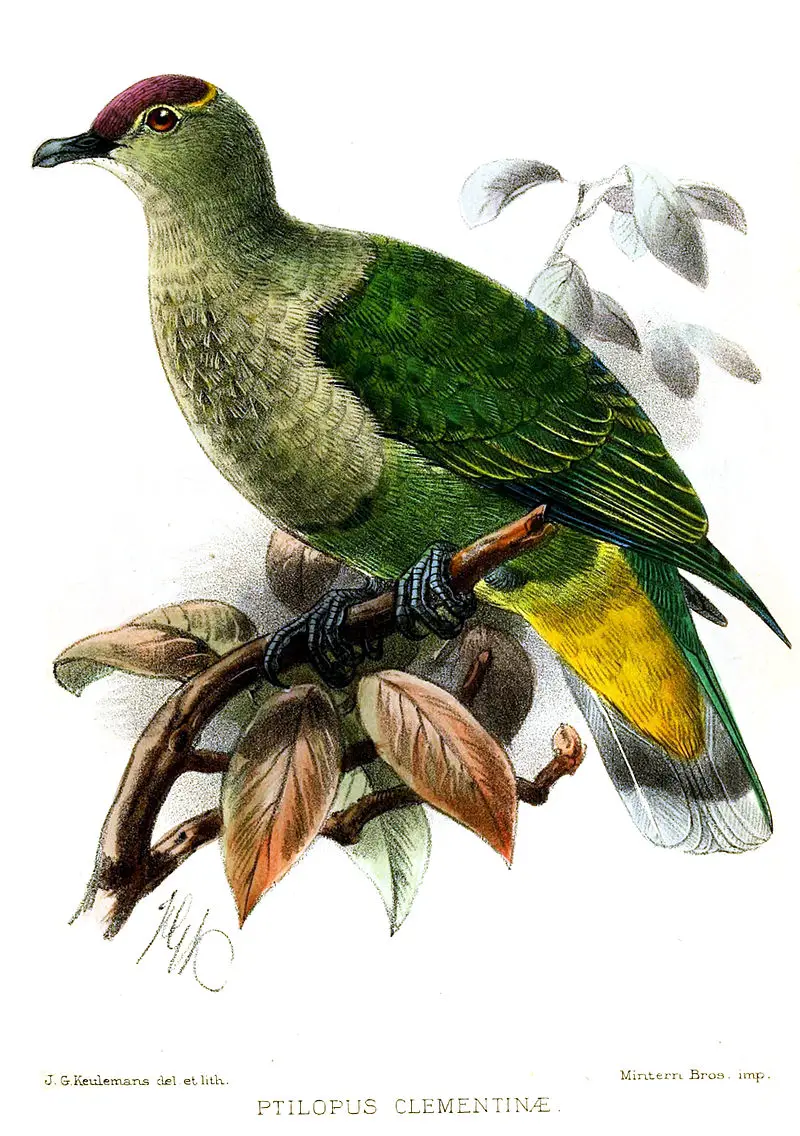
The Crimson-crowned Fruit Dove is a stunning species of bird that belongs to the Columbidae family.
It can be found in several locations throughout American Samoa, Fiji, Marshall Islands, Niue, Samoa Tonga and Wallis & Futuna Islands.
These birds usually inhabit subtropical or tropical moist lowland forests as well as mangrove areas. They are easily identified by their striking plumage – with shades of purple on top of a bright red crown.
Until 2016 both Purple-capped fruit dove and Kosrae fruit dove were considered subspecies but have since been classified as separate species.
This beautiful bird may be small but it certainly has an impressive presence.Scientific classification:
| Kingdom | Animalia |
| Phylum | Chordata |
| Class | Aves |
| Order | Columbiformes |
| Family | Columbidae |
| Genus | Ptilinopus |
| Species | P. porphyraceus |
28. Australian Pelican
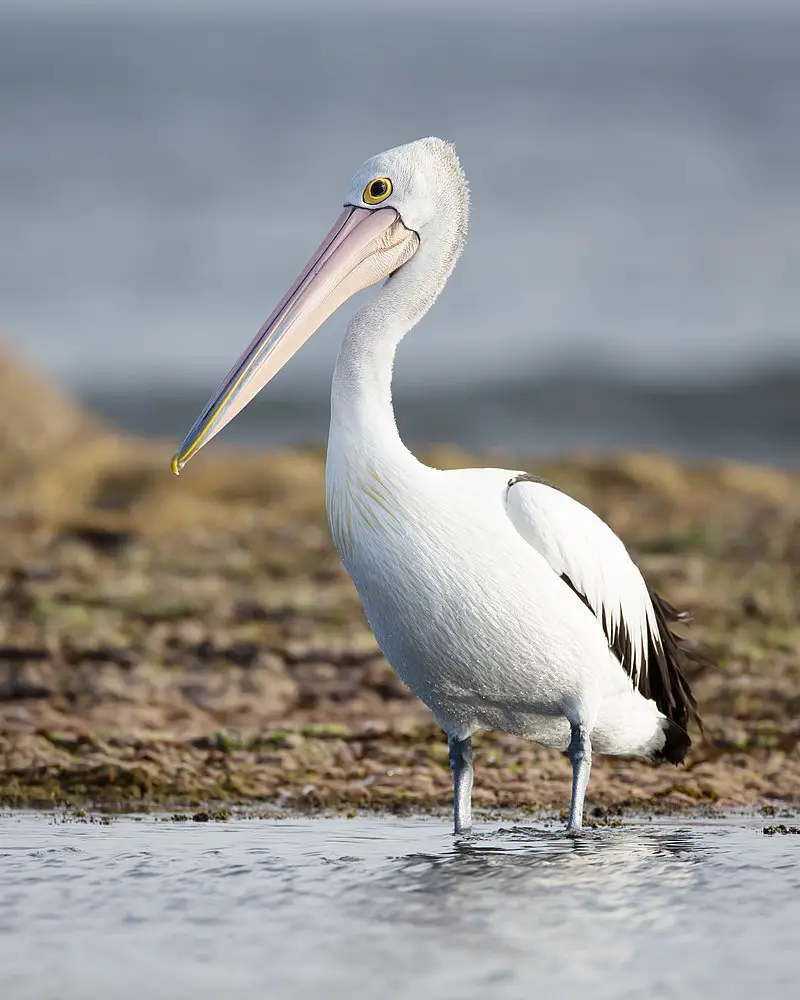
The Australian pelican is a majestic large waterbird with predominantly white plumage and black wings.
It has the longest bill of any living bird, which it uses to fish for its main source of food in both inland and coastal waters of Australia, New Guinea, Fiji, parts of Indonesia and as a vagrant in New Zealand.
They usually feed together by forming lines or circles around their prey before dipping down into the water at once.
In addition to fishing they also scavenge on other sources such as eggs from nesting seabirds or carrion.
Their unique appearance makes them an iconic species that can be easily recognised across many areas throughout Australasia making them popular amongst tourists who come to see them up close.Scientific classification:
| Kingdom | Animalia |
| Phylum | Chordata |
| Class | Aves |
| Order | Pelecaniformes |
| Family | Pelecanidae |
| Genus | Pelecanus |
| Species | P. conspicillatus |
29. White-Browed Crake
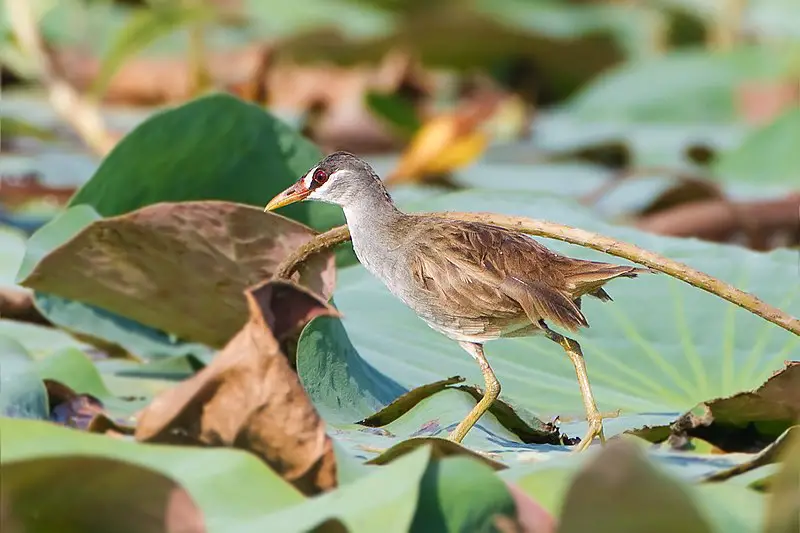
The White-browed Crake is an amazing bird found in many different parts of the world such as Australia, Brunei and even Japan.
It lives mostly in subtropical or tropical mangrove forests, where it can find plenty of food to survive on.
This species has a white head with brown eyes, combined with its slate grey back gives it a unique look that makes them stand out from other birds.
Its diet consists mainly of small invertebrates like insects and larvae but they also feed on fruits when available.
They are shy by nature so if you spot one be sure not to scare it away. Despite their rarity they have been known to breed successfully in captivity and thus have had some success at conservation efforts aimed at preserving this beautiful species.Scientific classification:
| Kingdom | Animalia |
| Phylum | Chordata |
| Class | Aves |
| Order | Gruiformes |
| Family | Rallidae |
| Genus | Poliolimnas Sharpe, 1893 |
| Species | P. cinereus |
30. Rotuma Myzomela
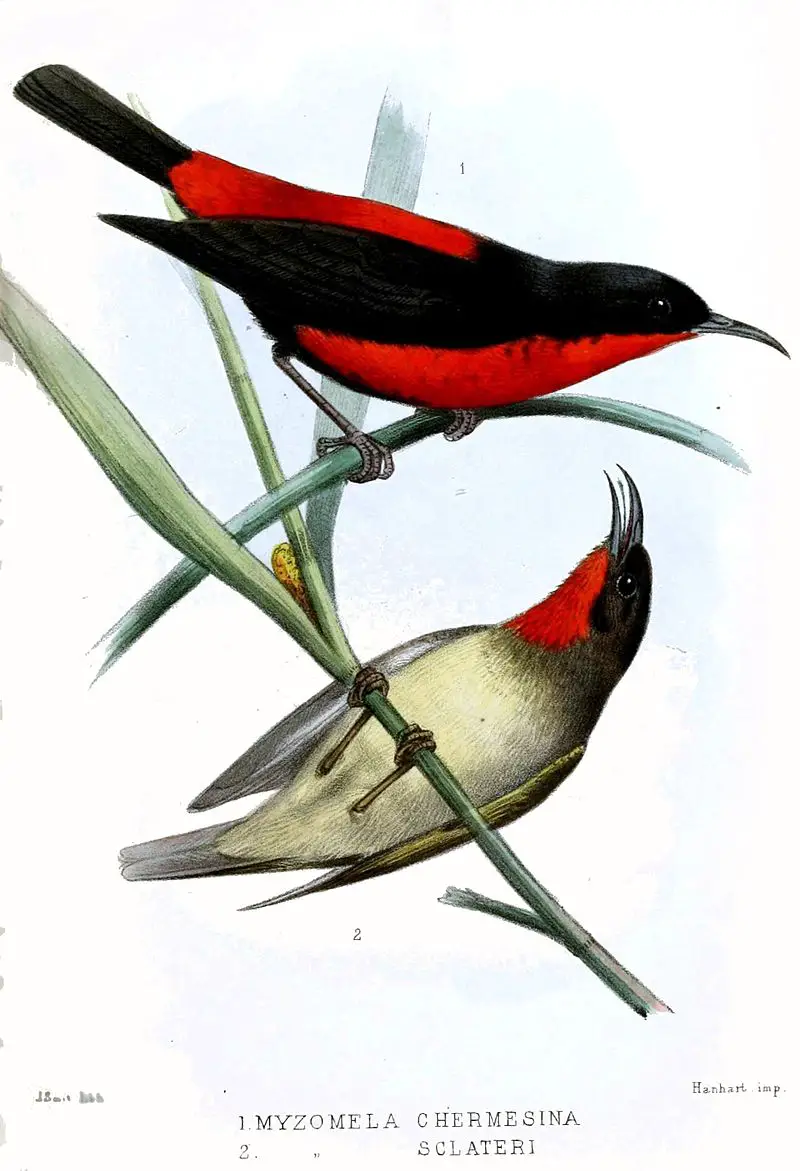
The Rotuma myzomela bird is a species of meliphagidae family, which is exclusively found on the island of Rotuma in Fiji.
It lives in tropical moist lowland forests and secondary forest as well as coconut plantations.
Despite its adaptability to habitat loss, it’s still classified as vulnerable due to its tiny range size.
Fortunately, conservation efforts have been made by local government and NGOs to help protect this beautiful little bird from further extinction risk.
The main threats they face are feral cats preying on them and human activities such burning or cutting down trees for farming land expansion or urban development that could lead to their habitats being destroyed over time if left unchecked.
With proper management plans put into action, hopefully these birds can continue thrive under our protection.Scientific classification:
| Kingdom | Animalia |
| Phylum | Chordata |
| Class | Aves |
| Order | Passeriformes |
| Family | Meliphagidae |
| Genus | Myzomela |
| Species | M. chermesina |
31. Vanikoro Flycatcher
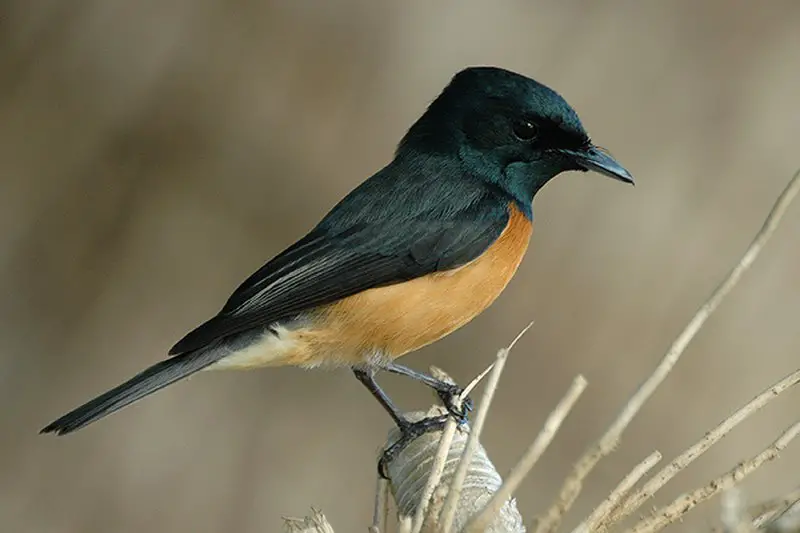
The Vanikoro flycatcher is a species of monarch flycatcher found in the southern Solomon archipelago on Vanikoro Island, as well as Fiji.
It was first described by French zoologists Jean Quoy and Joseph Gaimard in 1832 from a specimen collected on the island of Vanikoro.
This small bird has brownish-grey upperparts, with dark streaks along its back and wings; its underparts are white or cream colored with some streaking near its breast region.
Its distinctive feature includes a black face mask that covers both eyes, extending to form an “M” shape around them.
The bill is thick and yellowish-brown while legs are pinkish-gray. Although it prefers open woodlands for nesting purposes, this species can be seen flying over wetter habitats such as mangroves where they hunt insects midair or pluck prey off vegetation surfaces nearby waterside areas.Scientific classification:
| Kingdom | Animalia |
| Phylum | Chordata |
| Class | Aves |
| Order | Passeriformes |
| Family | Monarchidae |
| Genus | Myiagra |
| Species | M. vanikorensis |
32. Ogea Monarch
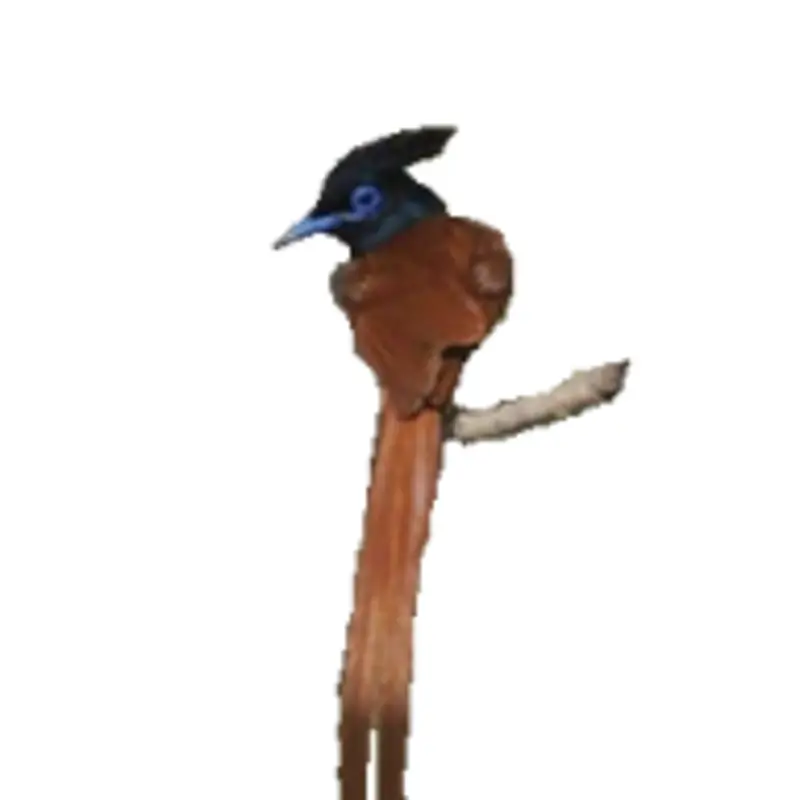
The Ogea monarch is an endemic bird species found in the Lau Group of south-eastern Fiji. It belongs to the family Monarchidae, and its alternate names are versicolored monarch or Mayrornis versicolor.
This little-known species feeds on insects and breeds around July. Its natural habitat consists of subtropical or tropical moist lowland forests which provide it with ample food sources as well as shelter from predators.
The Ogea monarch’s population size has not yet been quantified but conservation efforts must be implemented to protect this unique bird before it reaches a critical level that cannot be recovered from easily.Scientific classification:
| Kingdom | Animalia |
| Phylum | Chordata |
| Class | Aves |
| Order | Passeriformes |
| Family | Monarchidae |
| Genus | Mayrornis |
| Species | M. versicolor |
33. Black-Throated Shrikebill
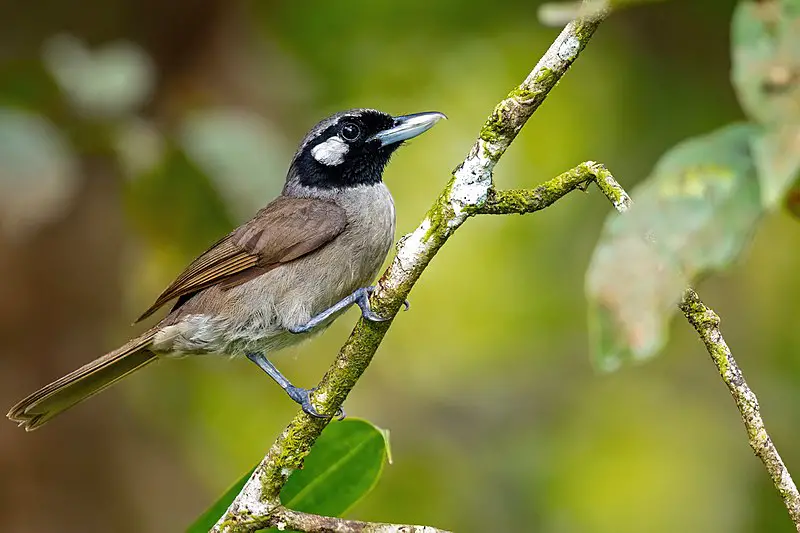
The black-throated shrikebill is an impressive songbird found in Fiji and the Solomon Islands. It has a distinctive black face with a white throat, giving it its name.
Its natural habitats are subtropical or tropical moist lowland forests and montane forests that provide plenty of cover to hide among branches and foliage while searching for insects, small lizards, fruit, seeds and nectar.
This species is threatened by habitat loss due to human activities including logging which can leave them without adequate food sources or nesting sites.
Originally described in the genus Clytorhynchus this bird was reclassified under Monarchidae in 2020 as more research revealed their unique characteristics within this family group such as shorter wingspan than other members of their genus.Scientific classification:
| Kingdom | Animalia |
| Phylum | Chordata |
| Class | Aves |
| Order | Passeriformes |
| Family | Monarchidae |
| Genus | Clytorhynchus |
| Species | C. nigrogularis |
34. Fiji Bush Warbler
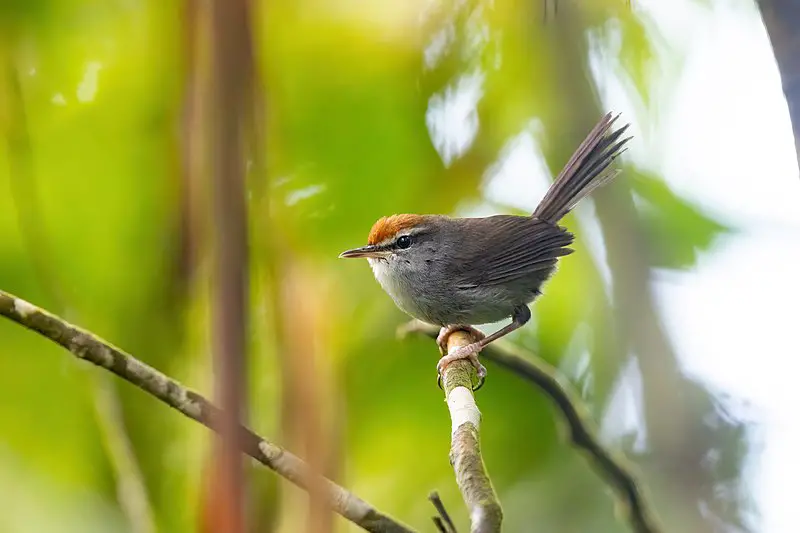
The Fiji bush warbler is a species of bird found only in the islands of Fiji. It belongs to the family Cettiidae and has four distinct subspecies, each occupying different main islands.
Its morphology, song and egg colour resemble other Horornis bush-warblers which have led it to be placed within that genus as well.
This small bird can be identified by its reddish brown feathers on its head and neck, yellow throat patch with white streaks running down from it, dark upperparts with faint barring pattern and yellow belly region.
Despite being endemic to this place, they are not considered endangered yet but their population should still be monitored closely for any changes or threats that could endanger them further in future times.Scientific classification:
| Kingdom | Animalia |
| Phylum | Chordata |
| Class | Aves |
| Order | Passeriformes |
| Family | Cettiidae |
| Genus | Horornis |
| Species | H. ruficapilla |
35. Natewa Silktail
The Natewa silktail is a species of bird native to Fiji. It has striking black plumage and looks like a miniature version of the iconic bird-of-paradise, though it is more closely related to fantails.
Measuring just 13 cm (5 in) long, this tiny beauty was named after Theodor Kleinschmidt who collected the first specimens for Museum Godeffroy in Hamburg.
While their population numbers are unknown due to lack of research, they can be seen flying around tropical forest areas searching for insects on which they feed.
With its iridescent feathers and bright yellow eyes, the Natewa silktail truly stands out from other birds found in Fiji’s lush forests.Scientific classification:
| Kingdom | Animalia |
| Phylum | Chordata |
| Class | Aves |
| Order | Passeriformes |
| Family | Rhipiduridae |
| Genus | Lamprolia |
| Species | L. klinesmithi |
36. Bar-Winged Rail
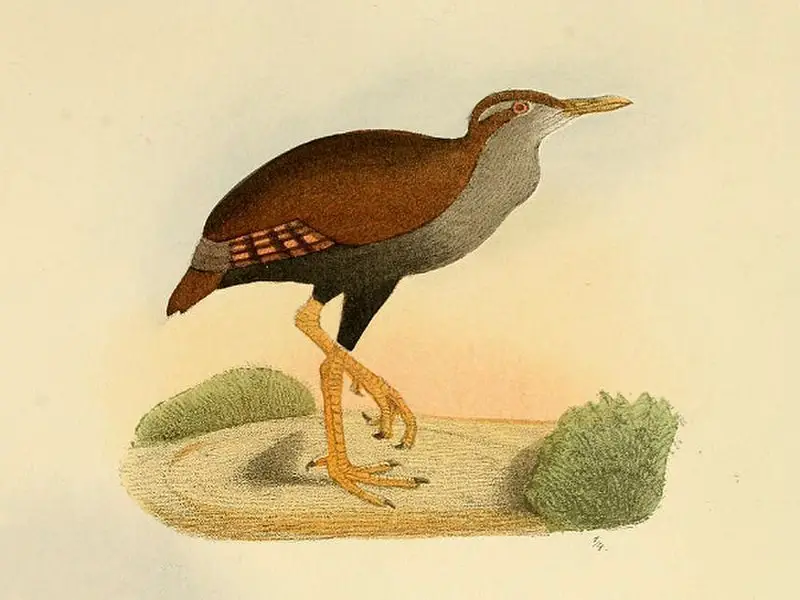
The Bar-winged Rail was a bird endemic to Fiji, last seen in 1973. It had been identified from twelve nineteenth century specimens, some of which are now held in museums around the world.
Fossil remains have also been found dating back to the late Pleistocene or early Holocene epochs.
The rail was about 28 cm long and had reddish brown wings with white spots along its upper parts as well as black barring on its underparts and flanks – hence it’s name.
Sadly this species is believed extinct due to habitat destruction for farming and development since 1890 when it was last collected on Viti Levu Island.Scientific classification:
| Kingdom | Animalia |
| Phylum | Chordata |
| Class | Aves |
| Order | Gruiformes |
| Family | Rallidae |
| Genus | Hypotaenidia |
| Species | †H. poeciloptera |
37. Polynesian Starling
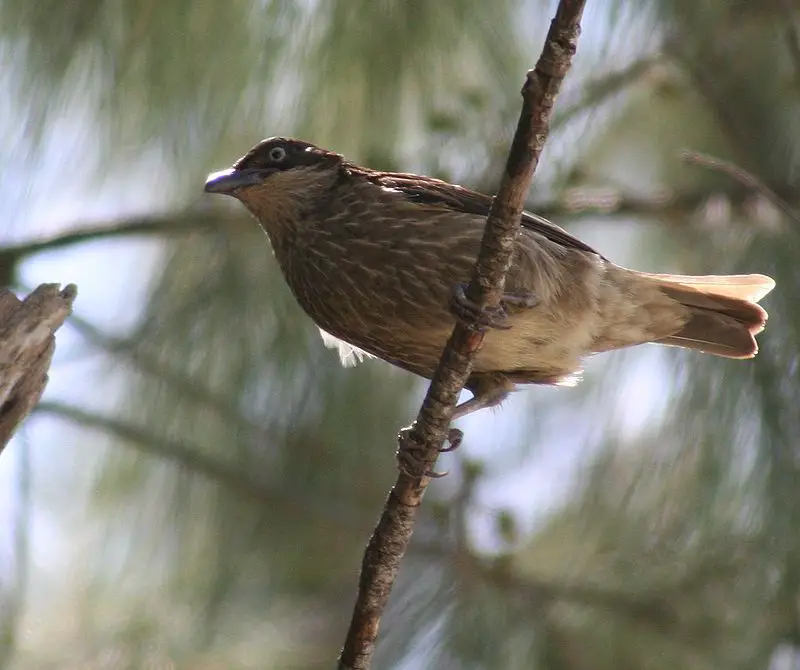
The Polynesian starling is a species of bird from the family Sturnidae. It is found in several places in Oceania, such as Samoa, Fiji, Niue and Tonga. Its habitats are subtropical or tropical dry forests and moist forests.
It varies in appearance depending on its location with some subspecies being darker colored than others.
This starling has a distinct call which can be described as raspy yet melodic at times.
Despite its wide range across the Pacific Islands it continues to face threats from human activities such as deforestation and agricultural conversion of land into plantations for crops like sugarcane that reduce their natural habitat .
Conservationists have called for increased protection efforts to ensure this beautiful species survives into future generations.Scientific classification:
| Kingdom | Animalia |
| Phylum | Chordata |
| Class | Aves |
| Order | Passeriformes |
| Family | Sturnidae |
| Genus | Aplonis |
| Species | A. tabuensis |
38. Polynesian Wattled Honeyeater
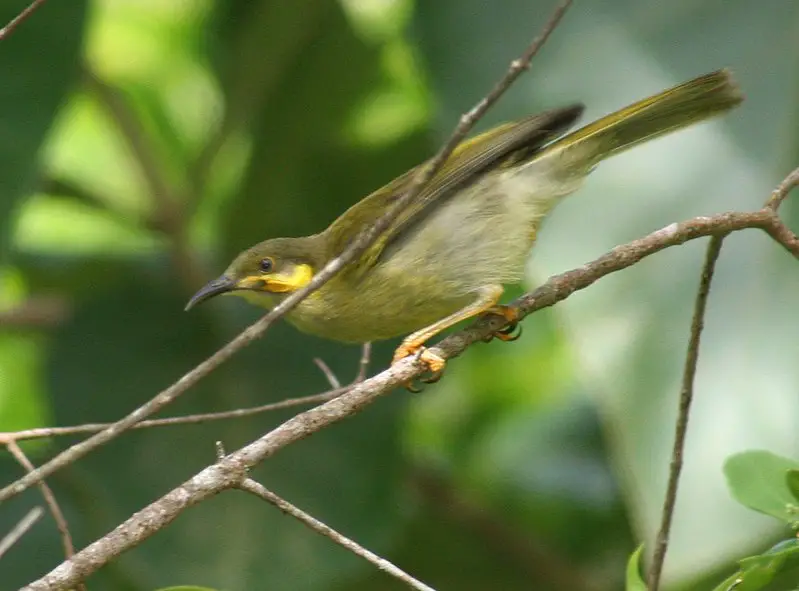
The Polynesian wattled honeyeater is a species of bird in the Meliphagidae family and can be found on American Samoa, Fiji, Samoa, Tonga and Wallis & Futuna Islands.
It was previously thought to be part of the same group as other wattled honeyeaters such as Fijian Wattles Honey Eater or Kikau but it has since been identified that they are all separate species.
They have small bills, stocky bodies with brown plumage on their back while greyish-white below along with yellow eyes.
In terms of habitat these birds prefer open forests, coconut plantations or mangroves which consist mainly of nectar-bearing flowers for them to feed upon.
They usually build their nests in dense foliage near water sources like streams or rivers making them hard to spot by potential predators due to its camouflage capabilities.
All in all this unique little creature is an important member within the Pacific Island avifauna providing us with a glimpse into our past ecology and natural beauty.Scientific classification:
| Kingdom | Animalia |
| Phylum | Chordata |
| Class | Aves |
| Order | Passeriformes |
| Family | Meliphagidae |
| Genus | Foulehaio |
| Species | F. carunculatus |